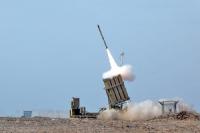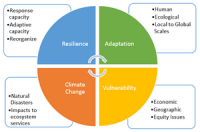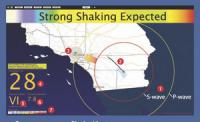-
Droughts caused permanent loss to major California groundwater source
California’s Central Valley aquifer, the major source of groundwater in the region, suffered permanent loss of capacity during the drought experienced in the area from 2012 to 2015.
-
-
A new way to sense earthquakes could improve early warning systems

Every year earthquakes worldwide claim hundreds or even thousands of lives. Forewarning allows people to head for safety and a matter of seconds could spell the difference between life and death. Researchers demonstrate a new earthquake detection method — their technique exploits subtle telltale gravitational signals traveling ahead of the tremors. Future research could boost early warning systems.
-
-
Wastewater treatment plants spread antibiotic resistance
The products of wastewater treatment have been found to contain trace amounts of antibiotic resistant DNA. These products are often reintroduced to the environment and water supply, potentially resulting in the spread of antibiotic resistance.
-
-
Easier access to radioactive waste
At the Hanford Site, waste retrieval has been completed in 17 of 149 large concrete underground single-shell tanks. The tanks were constructed of carbon steel and reinforced concrete between 1943 and 1964 to store a radioactive mix of sludge and saltcake waste from past nuclear processing activities. Hanford is installing new access holes in the tank domes for future retrieval efforts.
-
-
China's Huawei sues U.S. government over ban

Chinese tech giant Huawei has sued the U.S. government, arguing that legislation Congress passed last year that restricts its business in the United States is “unconstitutional.” The case, which analysts see more as a public relations move, is but the latest in an intensifying effort by the telecommunications company to fight U.S. security concerns, which Huawei argues are unfair and unfounded.
-
-
Forecasters use Iron Dome science to handle disasters

Typhoons, floods, droughts, earthquakes, hurricanes, wildfires — the frequency and intensity of natural disasters across the globe are worsening, and these deadly events could continue plaguing the planet as a result of climate change. Iron Dome tech firm uses rocket science to enable utilities to plan for and manage effects of wildfires, storms, hurricanes and earthquakes.
-
-
Using concrete for space colonies
“Be prepared.” This famous mantra isn’t just for the Boy Scouts of America. The need to build durable infrastructure on other planets is coming, and we must be ready. To prepare, researchers have been exploring how cement solidifies in microgravity environments.
-
-
“Clustering” land buyouts could improve flood resiliency after Hurricane Harvey
A new study analyzes flood loss claims and estimates from over 74,000 properties impacted by Hurricane Harvey in Houston’s Harris County. The study finds that a strategic land buyout approach that prioritizes the purchase of land parcels in ‘clusters,’ as well as proximity to existing open space, is just as cost-effective as the traditional, piecemeal approach but with major added ecological and social benefits.
-
-
Resilience and adaptation strategies can address the impacts of climate change

By the end of this century, Chicago could face the kind of searing summer heat that Las Vegas sees now. Phoenix could hit 110 degrees, 60 or more days a year. That’s not wild speculation. It’s the official position of 13 federal agencies on climate change, released late last year with a warning: Local governments need to do more to prepare. Every road they build, every storm drain they put in, will have to hold up under conditions that modern civilization has never seen. How do you plan for that? Researchers at RAND have been working on that problem for a while now.
-
-
Population increases, climate change will cause future U.S. water shortages
Climate change plus population growth are setting the stage for water shortages in parts of the U.S. long before the end of the century, according to a new study. Even efforts to use water more efficiently in municipal and industrial sectors won’t be enough to stave off shortages, say the authors of the new study. The results suggest that reductions in agricultural water use will probably play the biggest role in limiting future water shortages.
-
-
Simulating forest and fire dynamics to understand area burn of future wildfires

Climate change and wildfire – it’s a combustible mix with costly devastation and deadly consequences. With a goal of understanding the link between the two variables, researchers over the years have studied the effects of climate and wildfire interactions in the Sierra Nevada mountain range. That research has evolved into learning about the distribution of trees, the extent of forest cover and carbon dynamics.
-
-
Robots help in the demanding Fukushima cleanup efforts
In 2011, a tsunami triggered by a magnitude 9.0 earthquake all but decimated the Pacific Coast of Tohoku, Japan, including the Fukushima Daiichi power plant. A catastrophic meltdown ensued. Many tons of nuclear fuel, boiled down to a radioactive lava, corroded the steel surrounding the facility’s three reactors. Today, the cleanup effort is still projected to take several decades. S&T and NIST developed standard test methods for robots, which the Japanese government is now beginning to apply directly to their Fukushima cleanup efforts.
-
-
Better monitoring of nuclear power plants, nuclear proliferation
The United Kingdom is investing nearly £10 million (about $12.7 million) in a joint project with the United States to harness existing particle physics research techniques to remotely monitor nuclear reactors. Expected to be operational in 2024, the Advanced Instrumentation Testbed (AIT) project’s 6,500-ton detector will measure the harmless subatomic particles called antineutrinos that are emitted by an existing nuclear power plant 25 kilometers, or about 15.5 miles, away.
-
-
Long-distance earthquake detection
In traditional seismology, researchers studying how the earth moves in the moments before, during, and after an earthquake rely on sensors that cost tens of thousands of dollars to make and install underground. Now researchers have figured out a way to overcome these hurdles by turning parts of a 13,000-mile-long testbed of “dark fiber,” unused fiber-optic cable, owned by the DOE Energy Sciences Network (ESnet), into a highly sensitive seismic activity sensor that could potentially augment the performance of earthquake early warning systems currently being developed in the western United States.
-
-
L.A. showcases quake alert system

California is earthquake country, and residents of Los Angeles can now get some critical warning, when conditions are right, after a quake has started and seismic waves are heading their way. The long-delayed system, called ShakeAlertLA, is the first of its kind in the United States.
-
More headlines
The long view
Helping Strengthen America’s Critical Infrastructure
By Corinne Dionisio
Everyday life depends on a robust infrastructure network that provides access to running water, communications technology and electricity, among other basic necessities. The experts who keep our national infrastructure secure and resilient also need a strong network to share their knowledge and train the next generation of professionals capable of solving complex infrastructure challenges.
AI and the Future of the U.S. Electric Grid
By Doug Irving
Despite its age, the U.S. electric grid remains one of the great workhorses of modern life. Whether it can maintain that performance over the next few years may determine how well the U.S. competes in an AI-driven world.
Using Liquid Air for Grid-Scale Energy Storage
By Nancy W. Stauffer
New research finds liquid air energy storage could be the lowest-cost option for ensuring a continuous power supply on a future grid dominated by carbon-free but intermittent sources of electricity.
Enhanced Geothermal Systems: A Promising Source of Round-the-Clock Energy
By Julie Bobyock and Christina Procopiou
With its capacity to provide 24/7 power, many are warming up to the prospect of geothermal energy. Scientists are currently working to advance human-made reservoirs in Earth’s deep subsurface to stimulate the activity that exists within natural geothermal systems.
Experts Discuss Geothermal Potential
By Graeme Beardsmore and Rachel Webster, University of Melbourne
Geothermal energy harnesses the heat from within Earth—the term comes from the Greek words geo (earth) and therme (heat). It is an energy source that has the potential to power all our energy needs for billions of years.
